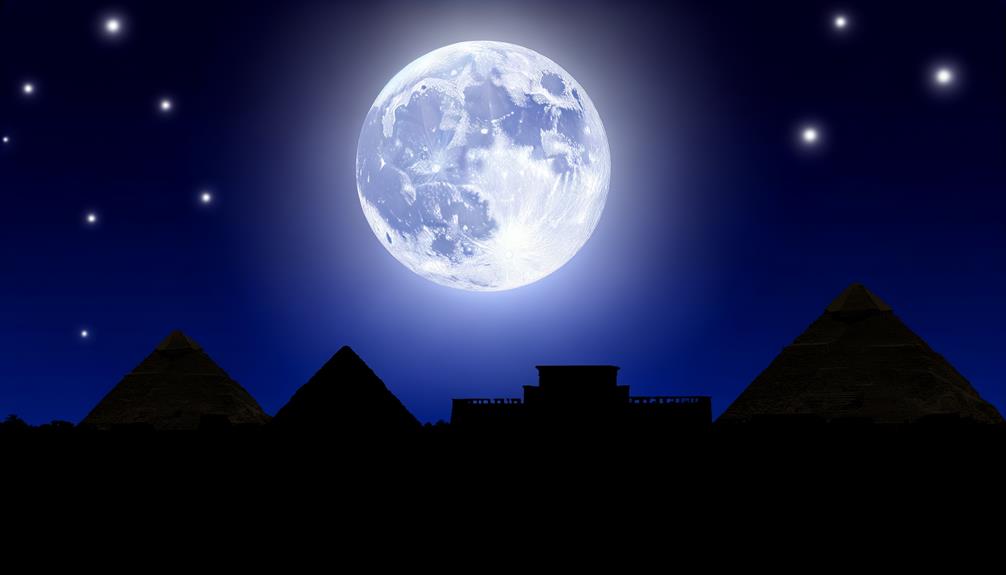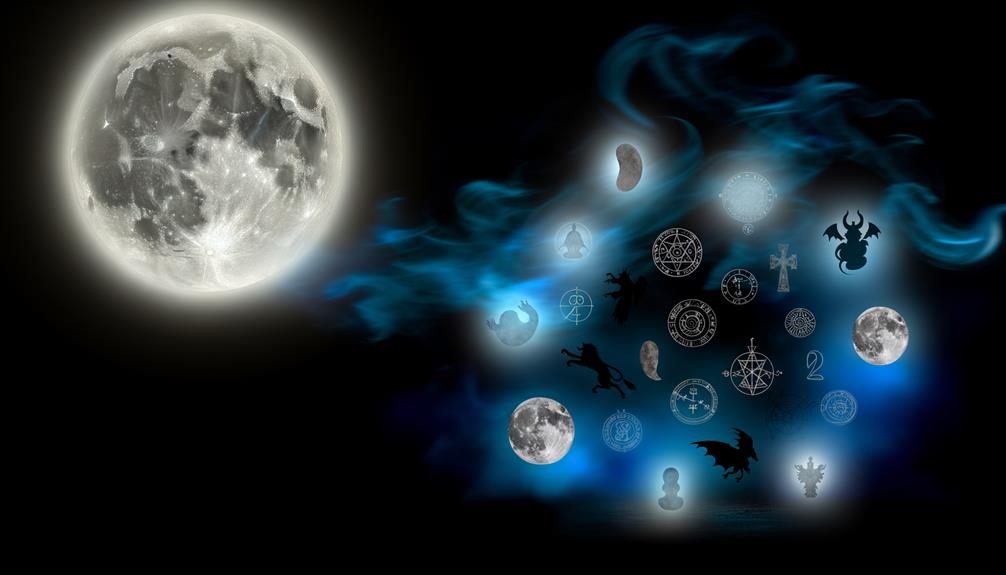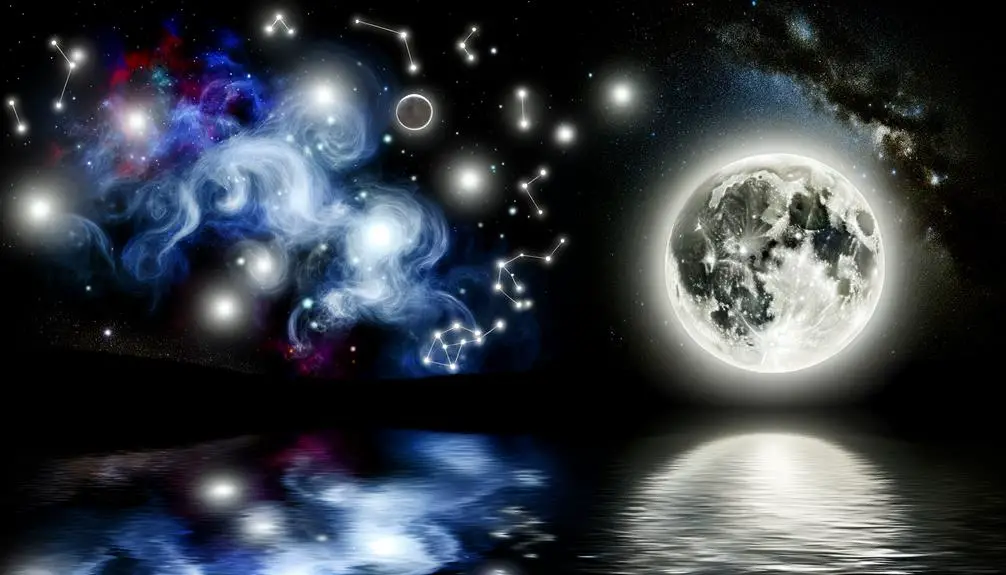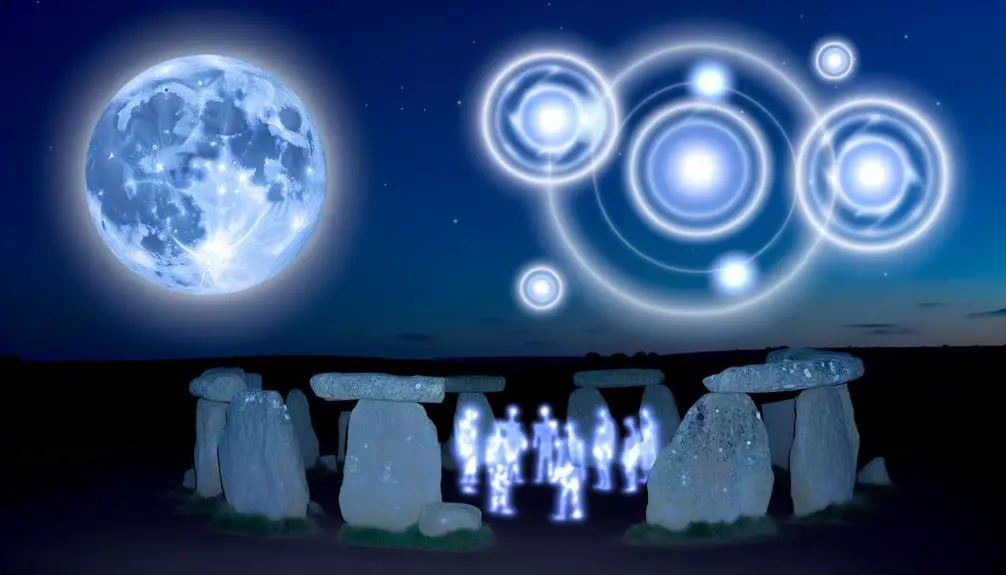What Does the True White Moon Symbolize in Astrology?
The true white moon, symbolizing fertility, renewal, and spiritual significance, is a powerful motif across multiple cultures. Historical narratives from ancient Mesopotamia to Greek mythology and indigenous North American tribes ascribe themes of purity and cyclical harmony to the moon.
Mythologically, deities like Selene, Artemis, and Chandra reflect the moon's transformative and intuitive powers. Ethnographic studies highlight lunar festivals and rituals marking agricultural cycles and spiritual renewal.
Astrologically, the white moon fosters personal introspection and emotional healing. Artistic representations further underscore its role in societal values and existential contemplation.
Explore these cultural layers to uncover a deeper understanding.

Key Takeaways
- The true white moon symbolizes purity, renewal, and spiritual enlightenment across various cultures.
- It represents fertility and transformation in mythologies such as Greek and Japanese folklore.
- Lunar phases are associated with emotional intuition, personal development, and introspection in astrological beliefs.
- Artistic depictions and rituals highlight the moon's mystery, unity, and cyclical harmony.
- The moon's symbolism transcends cultural boundaries, reflecting humanity's connection with natural cycles and spiritual practices.
Historical Perspectives

Throughout history, the symbolism of the true white moon has been intricately woven into the cultural, religious, and mythological tapestries of various civilizations.
In ancient Mesopotamia, the moon was revered as the god Sin, embodying wisdom and time-keeping.
Contrastingly, in Greek mythology, the moon goddess Selene represented the cyclical nature of life and death.
Ethnographic evidence from indigenous tribes in North America reveals lunar symbolism tied to agricultural cycles and spiritual rituals.
Comparative studies highlight shared themes of fertility, renewal, and celestial guidance across disparate cultures.
Cultural Significance
The cultural significance of the white moon manifests vividly through diverse practices such as lunar festivals and traditions, where communities celebrate its phases and symbolic meanings.
Mythological and folkloric narratives across various cultures often portray the moon as a powerful deity or mystical entity, reflecting its deep-rooted influence on human imagination.
Moreover, the white moon's symbolic representations vary globally, encapsulating themes of purity, transformation, and cyclical renewal in art, literature, and religious iconography.
Lunar Festivals and Traditions
Embracing the cultural significance of the True White Moon, numerous societies celebrate diverse lunar festivals and traditions that reflect their unique historical and spiritual narratives.
In East Asia, the Mid-Autumn Festival venerates the moon's fullness as a symbol of unity and abundance, accompanied by mooncakes and lanterns.
Comparatively, Indigenous North American tribes hold moon ceremonies to honor cyclical renewal and communal harmony, often involving drumming and storytelling.
In Hindu traditions, Karva Chauth sees married women fasting and praying for their husbands' longevity, culminating in moonrise rituals.
These festivals exemplify the moon's role as a cultural touchstone, weaving together collective memories and spiritual practices across disparate communities, highlighting the universal yet distinct ways humanity connects with the lunar cycle.
Mythology and Folklore
Numerous mythologies and folklore traditions across diverse cultures attribute profound symbolism to the True White Moon, often depicting it as a celestial entity imbued with mystical powers and moral narratives. In Greek mythology, Selene, the moon goddess, symbolizes purity and cyclical renewal, guiding mortals with her luminescent presence.
Conversely, in Japanese folklore, the moon harbors the elusive rabbit making mochi, a tale signifying perseverance and industriousness. Native American tribes like the Cherokee view the True White Moon as a spiritual overseer, linked with agricultural cycles and community well-being.
Each cultural narrative imbues the moon with traits reflecting societal values, serving as an ethereal touchstone for moral and existential contemplation. The moon's symbolism transcends mere illumination, becoming a mirror of human experience.
Symbolic Representations Globally
Exploring the cultural significance of the True White Moon reveals a tapestry of symbolic representations that reflect the diverse values, beliefs, and traditions of societies worldwide.
In East Asia, the white moon often symbolizes purity and renewal, central to festivals like the Mid-Autumn Festival.
Conversely, Indigenous cultures in North America regard the moon as a guide and protector, embodying wisdom and spiritual insight.
In Western esotericism, the white moon signifies the feminine divine, nurturing, and emotional clarity.
Comparative analysis illustrates that while the symbolic meanings vary, common themes of illumination and transformation emerge.
Ethnographic studies highlight that the moon's cyclic nature resonates universally, offering a shared metaphor for life's ebb and flow across different cultures.
Mythological Interpretations

Mythological interpretations of the true white moon span across various cultures, encapsulating rich narratives around lunar deities such as Artemis in Greek mythology and Chandra in Hindu tradition.
Ancient cultural beliefs often imbued the moon with profound significance, attributing to it powers of fertility, intuition, and transformation.
Additionally, the phases of the moon symbolized different aspects of human experience and natural cycles, reflecting a universal connection to the ebb and flow of life.
Lunar Deities Significance
Frequently revered across various cultures, lunar deities embody profound spiritual and mythological significance, reflecting humanity's enduring fascination with the moon.
In Greco-Roman traditions, Selene and Luna personify the moon's ethereal nature, symbolizing feminine mystique and cyclical renewal.
Contrastingly, in Hindu mythology, Chandra represents both the moon and a deity responsible for timekeeping, further linking lunar phases to agricultural cycles.
Ethnographic studies reveal that indigenous cultures, such as the Maori, revere the moon goddess Hina, attributing to her powers of fertility and navigation.
Such comparative analyses underscore the moon's universal emblematic resonance, depicting it as a celestial archetype that bridges disparate cultural narratives and spiritual ideologies, thereby enriching the global mythological tapestry.
Ancient Cultural Beliefs
Expanding on the symbolic significance of lunar deities, ancient cultural beliefs provide rich mythological interpretations that further elucidate the moon's revered status across civilizations. In ancient Greece, Selene personified the moon, a goddess driving her chariot across the night sky. Meanwhile, in Roman mythology, Luna held a similar role. Egyptian myths feature Thoth, a deity linked to lunar cycles and wisdom. The Aztecs revered Metztli, a god associated with the moon's phases and agricultural cycles. In Chinese traditions, Chang'e is a central figure, embodying the moon's beauty and mystery.
| Civilization | Lunar Deity |
|---|---|
| Ancient Greece | Selene |
| Roman Empire | Luna |
| Ancient Egypt | Thoth |
| Aztec Civilization | Metztli |
| Chinese Traditions | Chang'e |
These mythological interpretations underscore the moon's universal significance, connecting diverse cultures through shared reverence.
Symbolic Lunar Phases
Across various mythologies, the phases of the moon are imbued with profound symbolic meanings that reflect the cyclical nature of life and the universe. From the waxing crescent to the waning gibbous, each phase embodies unique themes and emotional resonances.
For instance, the new moon often signifies beginnings and potential in Greek mythology, while the full moon represents culmination and enlightenment in Hindu traditions.
- Renewal and Rebirth: The new moon symbolizes fresh starts, evoking feelings of hope and new possibilities.
- Growth and Development: The waxing moon phase is associated with progression and unfolding potential.
- Peak and Climax: The full moon stands for completion, clarity, and the height of power.
- Decline and Reflection: The waning moon signifies introspection, release, and the end of cycles.
These interpretations provide a rich tapestry of understanding the moon's influence on human culture and emotion.
Spiritual Enlightenment
Often regarded as a beacon of spiritual clarity, the true white moon serves as a powerful symbol in numerous cultures, representing the pinnacle of spiritual enlightenment.
In Hinduism, it embodies the serene wisdom of the god Shiva, while in Buddhism, it signifies the ultimate state of Nirvana.
Comparative studies reveal that indigenous tribes in North America view the white moon as a guiding force, leading individuals towards inner truth and spiritual awakening.
Ethnographic details from Celtic traditions illustrate moon worship as a path to heightened spiritual awareness, aligning lunar phases with personal growth.
These diverse cultural interpretations underscore a universal theme: the true white moon as an emblem of achieving higher consciousness and profound spiritual insight.
Astrological Insights

In the domain of astrology, the true white moon is interpreted as a celestial entity that influences emotional balance and personal growth, reflecting its symbolic significance across various cultural and spiritual frameworks. This astral body serves as a beacon for those seeking alignment and inner harmony, manifesting its power through nuanced astrological phenomena.
Its influence can be categorized as follows:
- Emotional Intuition: Heightens awareness of inner emotional states and fosters empathy.
- Personal Development: Acts as a catalyst for self-improvement and introspection.
- Spiritual Connection: Bridges the conscious mind with the subconscious, enhancing spiritual experiences.
- Cultural Symbolism: Varies across cultures, yet universally revered for its introspective qualities.
Comparative studies reveal its unique role in guiding individuals toward emotional and spiritual enlightenment.
Symbolism in Art
The true white moon's symbolism in art serves as a profound representation of emotional depth and spiritual transcendence, often depicted through varied cultural lenses and artistic expressions.
In Western art, it is frequently associated with themes of mystery and introspection, as seen in the somber hues of nocturnal landscapes by 18th-century Romantic painters.
Conversely, in East Asian art, the white moon often embodies purity and enlightenment, illustrated in minimalist ink paintings where its serene presence contrasts with the chaotic world below.
Indigenous cultures, too, imbue the white moon with rich narrative significance, portraying it in rituals and storytelling as a guardian or guide.
This cross-cultural analysis reveals a common quest for understanding the human condition through lunar symbolism.
Lunar Rituals

Amid diverse cultural contexts, lunar rituals often reflect a deep-seated reverence for the moon's cyclical phases, serving as a conduit for communal connection and spiritual renewal.
Through comparative studies, one can observe how these rituals vary yet share core thematic elements. Ethnographic detail reveals that such rituals imbue participants with a sense of belonging and continuity.
The emotive power of lunar ceremonies can be encapsulated in:
- Full Moon Celebrations – Promoting unity and collective intention.
- New Moon Meditations – Symbolizing fresh starts and introspection.
- Eclipse Observances – Interpreted as times of transformation and revelation.
- Seasonal Lunar Festivals – Marking agricultural cycles and ancestral homage.
These practices illustrate the moon's profound impact on human culture, transcending geographical boundaries.
Modern-Day Relevance
Today, lunar rituals continue to hold significant relevance, providing a bridge between ancient traditions and modern spiritual practices. In contemporary times, the symbolism of the white moon has transcended cultural boundaries, influencing various spiritual and wellness communities globally.
Comparative studies reveal that, much like their ancient counterparts, modern practitioners utilize the moon's phases for meditation, manifestation, and emotional healing. Ethnographic details highlight that rituals such as moon bathing and lunar journaling are prevalent in diverse cultures, from Western holistic practices to Eastern spiritual traditions.
The ongoing fascination with the moon underscores a collective human desire to connect with natural cycles, offering a sense of continuity and grounding in an increasingly digital and fragmented world.
Conclusion
In summation, the true white moon symbol, rich in historical, cultural, and spiritual significance, serves as a multifaceted emblem across various societies and epochs.
Its representation in mythology, art, and astrology, much like the moon itself, waxes and wanes, reflecting humanity's evolving understanding and reverence.
This symbol, akin to a mirror, captures the luminescence of human beliefs and aspirations, continually illuminating the path toward spiritual enlightenment and contemporary relevance in an ever-changing world.






